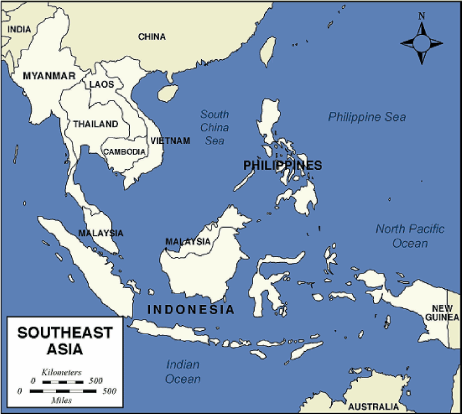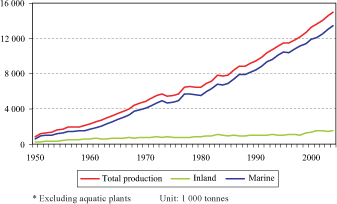This summary of the history of marine fisheries in Southeast Asia traces the development of fisheries in the region from basically subsistence activities in the nineteenth century to large-scale industrial fishing in the latter part of the twentieth and early twenty-first centuries and examines the impact that this development has had on fish stocks and fishing communities in the region. The work is based substantially on the comprehensive review by Butcher (2004) although other sources have also been used as appropriate. Units of measurement have, where possible, been standardized to metric units to facilitate comparisons with current and other data, although Butcher’s (2004) units for weights and measures of measurement are already quoted in metric units except where other units are referred to in a statute, law or other legal instrument. However, there are instances, particularly for the measurement of vessel tonnage, where such standardization has not been possible and these instances are highlighted and discussed as they occur.
The geographical area covered by this history is shown in Figure 1 and includes all of the countries of Southeast Asia, excluding China to the north and Australia to the south. The time period covered is approximately from the mid-nineteenth century to the present day (2005).

Figure 1. Map of Southest Asia showing the area and countries covered by this review
Although inland and estuarine fisheries are also important in Southeast Asia, the seas of the region have been particularly important and have long provided people with a variety of fish, shrimps, squids, whales, pearl oysters, sea cucumbers and a multitude of other animals that they have collected and captured for medicine, oil, jewellery and most importantly food.
Prior to the early 1900s, the population of the whole of Southeast Asia was about 40 million with the majority of that population living in villages. The countries of the area were not yet urbanized to any great extent and therefore fishing (both marine and inland) was directed mainly at the need to supply food for these village communities. There was some limited trade (often between coastal and inland villages) and simple preservation and processing methods such as salting, drying and the manufacture of fish sauce which were developed and used to facilitate this trade. The supply of fresh, preserved or processed fish for large centralized markets, either domestic or international, was largely unknown.
As a result of this subsistence fishing by coastal villages in the nineteenth century, the region’s marine fish stocks were almost certainly lightly exploited and, although no detailed surveys were carried out until after 1945, several contemporary nineteenth century records comment on both the quality and the abundance of fish in many areas and on the simple fishing methods used in marine fisheries.
Restricted by the simple fishing gear and vessels, and with abundant coastal fish resources, most fishing was undertaken in near-shore waters. When the demand for fish and other marine animals rose or the supply fell (often as a result of natural causes, such as the monsoons), it was a relatively simple matter to expand operations into new coastal fishing grounds since there were very few barriers to such expansion.
As fishing moved away from a subsistence-level activity and became increasingly oriented towards supplying more remote markets in the late 1800s and early 1900s, a spectacular growth in catches occurred (Sugiyama et al., 2004). This expanding demand for marine products was created above all else by urbanization and the growth in population but also by the development of transport and marketing systems and changes in the techniques in preserving fish, shrimps and other marine life that prompted people to produce for the market.
This expansion of marine production accelerated after the Second World War as fleets were mechanized and fishing activities expanded to new areas, particularly those areas offshore that had previously been unfished or, at least, only lightly exploited. Figure 2 shows the extent of this increase in landings in the last half of the twentieth century and, particularly, how this expansion in marine landings overwhelmed production from inland waters. The expansion of marine landings in Southeast Asia has been so spectacular that two nations in the region (Thailand and Indonesia) are now among the world’s top 10 fish producing nations and marine fisheries production accounts for more than 1 percent of GDP in almost all countries of the region (Sugiyama et al., 2004, Table 1).
With this expansion in landings through the twentieth century came an expansion in the areas fished by national fishing fleets, a decline in the abundance of many fish stocks and, accordingly, an increase in interest at the regional, national and international level, in administering, controlling and regulating fishing activities in the region. States, and since the late 1940s, international organizations have all influenced the scale and location of fishing in the region and, until recently, fishing often took place beyond the reach and grasp of state powers.
The ability to expand landings by moving to new areas was curtailed in the latter part of the twentieth century not only by the lack of new fishing grounds to move to but also very much by this increasing interest of national Governments (and the legal obligations and powers conferred by the UN Convention on the Law of the Sea, UNCLOS) to control fishing activities, particularly fishing by other nations’ fleets, within a nation’s territorial waters. Such recent attempts at regulating fisheries have not been wholly successful since they are built on a long history of a lack of government intervention and control in the marine fisheries sector. However, as Butcher (2004) points out, the era of opening of new “frontiers of fisheries has ended. The challenge now is to exploit the seas in a sustainable manner that preserves the diversity of marine life while providing the people of the region with a source of food long into the future”.

Figure 2. Chart showing the increase in production
from marine
areas of Southeast Asia
from 1950 to 2004
In examining how the various sectors of marine fisheries in Southeast Asia have developed since the nineteenth century and how they have contributed to the overall rapid expansion of landings, the individual components that comprise the region’s marine fisheries sector will be examined. These components include: (a) pearling; (b) trawling; (c) purse seining; (d) shrimp trawling; (e) tuna longlining, poling and purse seining; (f) driftnetting; (g) trolling; and (h) other industrial fishing operations, including failed types of industrial fishing.
In addition, the current state of each of these sectors and the resources upon which they rely will be examined so that an assessment can be made for each sector of the likelihood of being able to move from an expansionist mode of fishing (where landings were increased by exploiting new areas) to one of sustainability, based on existing resources.